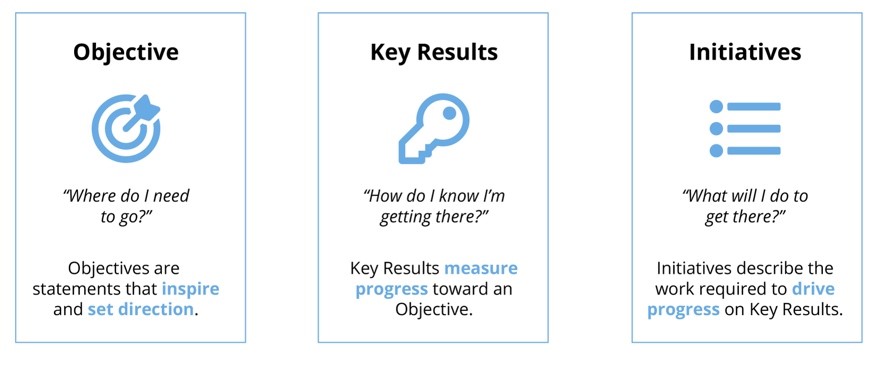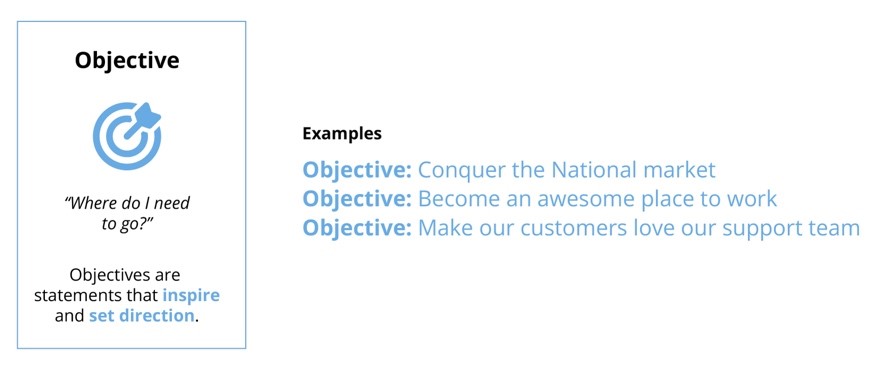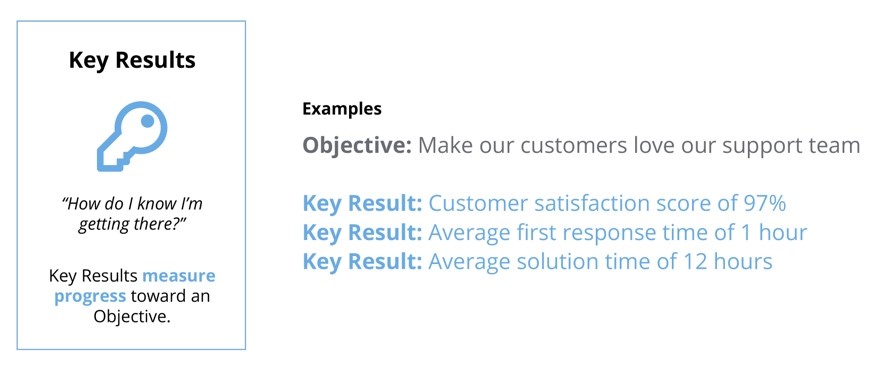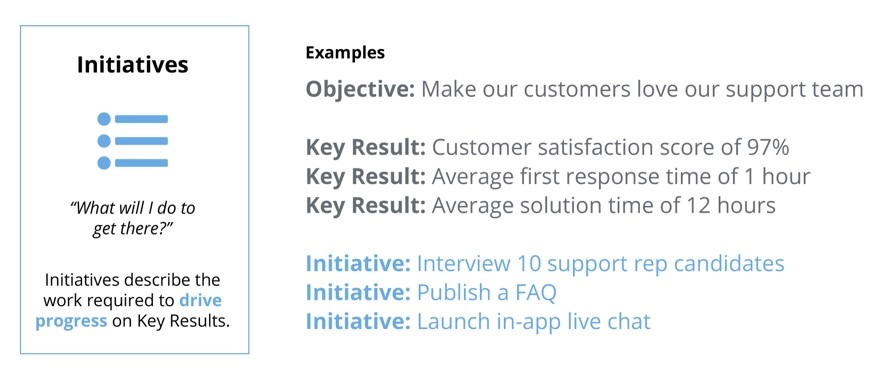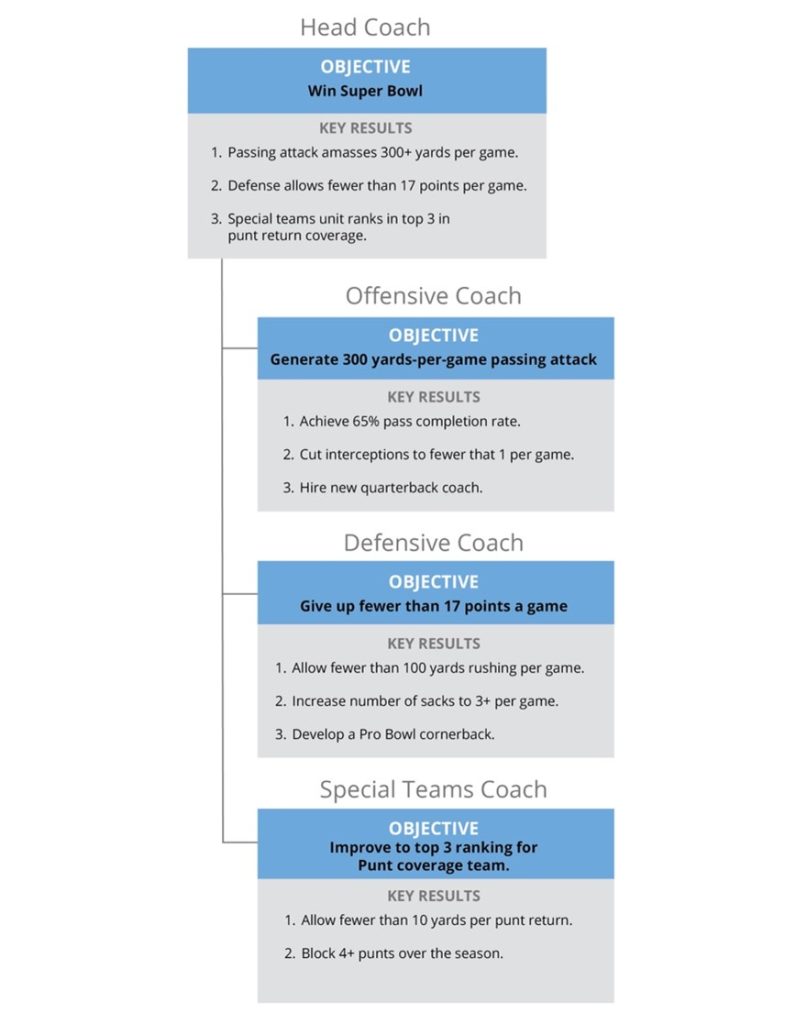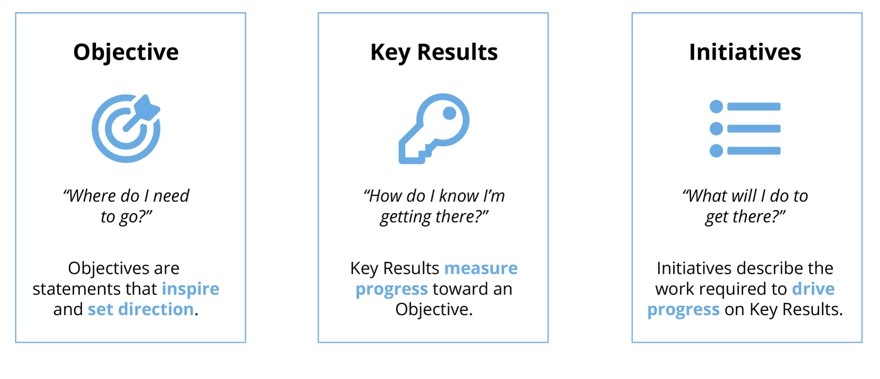
Now that we’ve crafted our OKRs, it’s time to focus on how teams within your company can work together to accomplish these goals. While OKRs empower teams with a significant amount of autonomy, the key to overall corporate success lies in connection and alignment. As you communicate your corporate OKRs, it’s crucial that everyone in the organization not only understands them but also recognizes their importance and how they contribute to the company’s success. A well-executed alignment process creates a direct line of sight from every individual employee back to the corporate OKRs.
Connecting OKRs from top to bottom within your organization helps illuminate the relationship between what employees do and how those actions lead to overall strategy execution. This connection fosters learning in two directions. First, as business units, departments, and individuals develop their OKRs, they showcase their unique roles in creating value for the company. To do this effectively, they must understand the business’s strategy, which deepens their grasp of the organization’s purpose. Second, as leaders analyze OKR scores across the company, they gain valuable insights into how different parts of the business are contributing to the overall strategy.

How Deep to Connect
Ultimately, your goal should be to extend the use of OKRs throughout the entire company. But how quickly should this be done? Should you rush to connect all levels within the first year, or take a more measured approach over several years?
OKRs have the potential to be a transformative tool for your business, sparking new thinking that leads to previously unimagined levels of success. To realize this potential, the framework must be embraced and utilized at all levels of the company, helping you foster fluency in a new corporate language: strategy execution. The faster you connect, the faster your employees will master this new approach, and the sooner you’ll see results.
We believe in the power of momentum and recommend moving aggressively but thoughtfully when connecting OKRs. Aggressively means connecting quickly and deeply across all levels of the company. Thoughtfully means ensuring you can answer these critical questions affirmatively before proceeding:
- Do we have executive support for OKRs?
- Do we have a clearly documented strategy reflected in our top-level corporate OKRs?
- Are we committed to using OKRs to manage the business, regardless of the initial results?
If you can overcome these hurdles, a rapid rollout may be appropriate.
Preparing Your Groups for Connecting

In a previous post, we discussed the importance of a mission statement, which conveys your core purpose as an organization. Every business group that will create connected OKRs should develop a mission statement that clearly outlines why they exist and how they add value to the organization.
Armed with their mission statements, each group must then answer a fundamental question: “How do we support the organization’s mission and strategy?” This question primes groups for the task of connecting by having them enumerate in advance how they are going to support the company’s overall strategic goals.
The Key to Connecting Is Influence
The purpose of the connecting exercise is to allow all groups—even individuals—to show how they influence the overall corporate OKRs. This process begins with the top-level set of OKRs. These are the critical levers of your success, and everyone in the company must deeply understand them before you begin connecting. Let’s assume you’re starting from the corporate level. The first real connection occurs when business units study the corporate OKRs and ask, “Which of these OKRs can we influence the most, and how?”
The goal of a well-executed connection process is to provide a direct line of sight from every individual employee all the way back to the corporate OKRs.
Creating Alignment
Ensuring your people are aligned around a common purpose is the number one job for any successful corporation. Connecting OKRs provides an outstanding opportunity to drive that alignment through every job and function in your firm. There are two types of alignment you’ll be fostering during the alignment process: vertical and horizontal.
Vertical Alignment
This is the type of alignment most people think of when considering connecting goals across an enterprise. Vertical alignment creates OKRs that flow downward, eventually reaching the individual employee level. However, as we’ve previously noted, this does not mean the executive team dictates a number of obligatory goals that are forced upon lower-level groups regardless of fit or necessity. Instead, vertical alignment is facilitated when teams, departments, or individuals look to the OKRs of the group to whom they report and ask: “How can we influence those OKRs? What can we do and measure at our level to drive both our success and theirs?”
Here’s an example of driving vertical alignment: The CEO of a mid-sized company declared that customer retention was the top priority. Traditionally, customer retention had been the sole domain of the customer success team, which managed ongoing client interactions and renewals. After the CEO’s announcement, everyone assumed that the customer success team would simply work harder to drive retention while other departments would continue focusing on their current priorities. However, with OKRs in place, the company could create a culture of alignment across all teams.
The product team, for instance, had typically focused on features that would attract new customers or differentiate the company from the competition. With the new focus on customer retention, they began asking, “How does this product improvement drive customer retention?” The marketing team also shifted its outlook, taking time at their user conference to interview customers and gather valuable survey data on retention. Even the sales team adjusted its approach, now taking time to call on their installed base to ask how they could add more value and emphasize long-term relationships.
Each of these teams did something different—something relevant to their specific function—but the common denominator was identifying actions that supported the corporate strategy of increasing customer retention. That’s vertical alignment in action.
Horizontal Alignment
While most companies are familiar with the concept of vertical alignment, horizontal alignment is equally important but often overlooked. In the modern enterprise, much of the work involves disparate teams coming together to solve customer issues or create new value. When one unit can’t depend on another, damaging consequences such as duplication of effort, missed opportunities, and escalating conflicts can occur. OKRs can help fill this gap.
Creating horizontal alignment isn’t complicated. It simply requires having the discipline to hold detailed conversations with other units throughout the company to discover mutual dependencies. Both teams then create OKRs that reflect these dependencies. The resulting OKRs may be unique to each unit, or in some cases, they may decide to use “shared OKRs.” Shared OKRs are particularly useful when multiple teams work closely together to achieve a result, ensuring that everyone is aligned and contributing to the overarching goal.

Confirming Alignment of Connected OKRs
Creating a set of corporate OKRs that improves focus on what really matters is one thing. However, the value of an OKR implementation increases exponentially when you connect, allowing all participants to announce their contribution to the bigger picture. Connecting may be the most essential part of your OKR process, so it’s critical to ensure it’s done well. Once you begin rolling out the program and having lower-level groups develop their OKRs, you can’t assume that those OKRs are aligned. You must check each set to ensure they draw a clear line of sight back to your strategic goals.
Next up… Managing Effectively with OKRs.

Bill Gelbaugh is one of our Senior Partners here at Outhouse and champions our OKR efforts.




